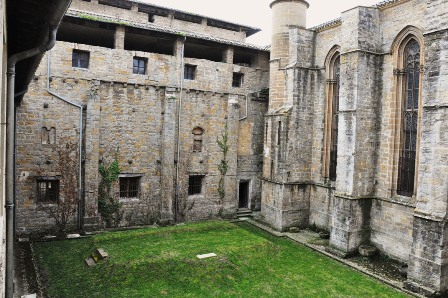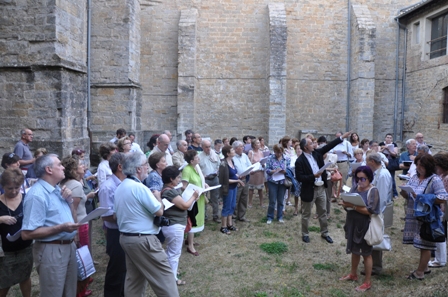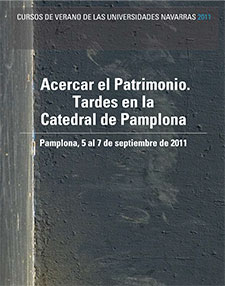BRINGING HERITAGE CLOSER. EVENINGS IN PAMPLONA CATHEDRAL.
6 September 2011
A stroll through the canonical dependencies of the cathedral
Mr. Javier Martínez de Aguirre. Complutense University of Madrid
The regular life of the canons of Pamplona, promoted by Bishop Pedro de Roda at the end of the 11th century, required the existence of adequate spaces for conference room chapter house, dormitory, refectory, kitchen and storeroom. Under the impulse of this reformist French prelate, a Romanesque canonical building was built, organized in a nave with two levels that has survived to the present day under the name of "cillería". Still in the Romanesque period and around the cloister, a refectory and a chapter house conference room were built, later replaced by Gothic constructions.
In the second half of the 12th century, the bishops of Pamplona built a large palace, with an L-shaped floor plan, which had an enormous hall, a chapel (probably the one known as "of Jesus Christ") and rooms for the private life of the prelate (chambers, kitchen, etc.). In the second half of the 13th century this palace was given to the cathedral chapter. The canons then saw the opportunity to remodel all the rooms, making them more spacious and beautiful. At the end of the century, the gothic cloister Building was begun, around which the new rooms were organized. A dormitory was built around the great hall of the Romanesque palace, and on the upper floor of the wing of the bishop's private quarters, a large space called the "chamber of the belvederes" was built, where the chapter meetings were held. Recently, the gothic oriels of this room have been discovered. Around 1330 the monumental Gothic refectory was erected, which deviated its axis so as not to break into the southern nave of the old episcopal palace, and next to the refectory the kitchen, one of the most impressive among those preserved in Europe at the time.
As the dormitory occupied during the 14th century was damp and unhealthy, the vicar of the diocese Don Lancelot financed a new one, with wooden cells, splitting at average height with transverse arches the old great hall of the Romanesque palace. Thus, from then on, the dormitory was raised to the full satisfaction of the canons, who used it for centuries.
The oriels' chamber was not always used as a chapter house conference room . The Barbazana Chapel occupies in the cloister the usual place for this subject of rooms and has the optimal dimensions to fulfill this function, but it was not frequently used as such, while it did consolidate its use as a consistory (seat of the episcopal court). In the 16th century, the canons moved their meetings to a new conference room, located in the vicinity of the dormitory. The conference room de los miradores was also transformed at the end of the 16th century into a daily refectory, leaving the Gothic refectory for important occasions.
The 18th century brought considerable modifications. A new chapter house conference room was built behind the ambulatory of the cathedral church, between the two sacristies. In the Age of Enlightenment, it was decided to build a monumental high Library Services , which led to an enormous Structures: a new portico, a powerful archway on two levels, two galleries above the chapel of Jesus Christ and the great hall to house the bookshelves and books. As a consequence, the former oriel chamber, converted into a refectory, no longer had a view of the orchards. In the 19th century, the courtyard of the refectory, located between the refectory and the old Romanesque palace, received a new gallery, replacing one of medieval origin, probably made of fragments of the disappeared Romanesque cloister. The end of the regular life (mid-19th century) meant a radical change in the uses of all these rooms. The Gothic refectory was converted into a chapel and each of the canonical rooms was given a new use. At the beginning of the 20th century, the construction of a new chapter house conference room in the old upper dormitory was even considered, project which failed and meant the last major alteration of all these spaces, whose complex history is being reconstructed step by step thanks to the combination of archaeological, archival and typological research.

Confluence of the Romanesque episcopal palace and the Gothic refectory of the cathedral of Pamplona.

One of the moments of the visit of professor Martínez de Aguirre to the canonical dependencies, in the space of the cloister.
PROGRAM
Monday, 5th September
The Cathedral in the History of Navarre: the cathedral, the chapter, the institutions and the bishop.
D. Luis Javier Fortún Pérez de Ciriza. Royal Academy of History
Capitals and keystones of the Cloister of Pamplona Cathedral. That unknown world
Ms. Clara Fernández-Ladreda Aguadé. University of Navarra
Travellers' views of Pamplona Cathedral
Ms Carmen Jusué Simonena. UNED of Pamplona
Tuesday, 6th September
Sumptuary arts in the Cathedral
D. Ignacio Miguéliz Valcarlos. Chair of Navarrese Heritage and Art
Artists in the Cathedral. Esteban de Obray, master of choir stalls.
Ms. María Concepción García Gainza. Chair de Patrimonio y Arte Navarro
A stroll through the canonical dependencies of the cathedral
Mr Javier Martínez de Aguirre. Complutense University of Madrid
Duplicate visits to the cathedral complex in Pamplona
Wednesday, 7th September
Golden scenery: the baroque altarpieces
D. Ricardo Fernández Gracia. Chair of Heritage and Navarrese Art
The cathedral today and tomorrow: projects in progress
D. Francisco Javier Aizpún Bobadilla. Episcopal Vicar for Heritage. Archbishopric of Pamplona
CLOSING: Concert at position Choir Santa María la Real de Voces Graves

